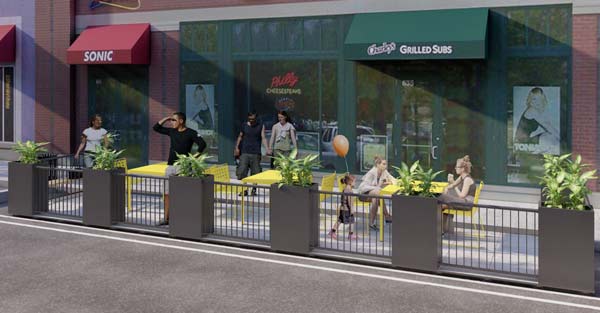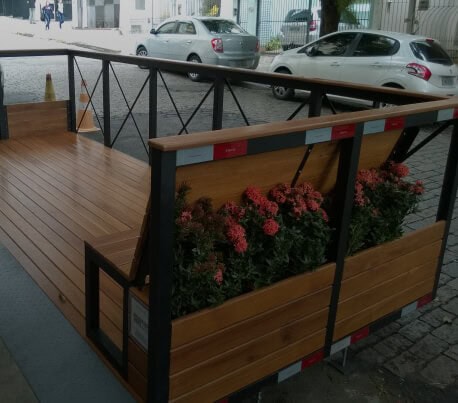Parklet Design & Construction
Bringing your parklet vision into reality.
The most critical factors in bringing an initial vision for a public parklet into reality are:
 Complying with all regulations on positioning and design od street seating structures
Complying with all regulations on positioning and design od street seating structures
 Funding the cost of materials, design work and construction
Funding the cost of materials, design work and construction
 Designing a unique, attractive, functional, yet removable structure
Designing a unique, attractive, functional, yet removable structure
 Guaranteeing ongoing maintenance, repairs and seasonal removal (where applicable)
Guaranteeing ongoing maintenance, repairs and seasonal removal (where applicable)
The Permit Process
To bring your vision to fruition, you’ll need to begin the permit application process as soon as possible. This process will vary depending on your location, but the notes below should help with some initial guidance of what to expect.
 First you’ll need to nominate an individual or group who is prepared to accept responsibility and stewardship for managing the entire process, who is prepared to accept liability and is committed to meeting all maintenance requirements and expenses.
First you’ll need to nominate an individual or group who is prepared to accept responsibility and stewardship for managing the entire process, who is prepared to accept liability and is committed to meeting all maintenance requirements and expenses.
 Find out the time frame in which parklet proposals are accepted by the city. Contact the department responsible for managing parklets (commonly the Department of Transportation) and ask them about their deadlines. Proposals are typically only accepted within a short period of time each year.
Find out the time frame in which parklet proposals are accepted by the city. Contact the department responsible for managing parklets (commonly the Department of Transportation) and ask them about their deadlines. Proposals are typically only accepted within a short period of time each year.
 Build your case for establishing a parklet in the community, get local support and finalize financing. Inform neighboring business owners, residents and merchant organizations of your intention and ask for letters confirming their approval, which you will submit with your application. This is a critical step, as public rejection after your application is submitted could cause significant delays.
Build your case for establishing a parklet in the community, get local support and finalize financing. Inform neighboring business owners, residents and merchant organizations of your intention and ask for letters confirming their approval, which you will submit with your application. This is a critical step, as public rejection after your application is submitted could cause significant delays.
 Contact the local department responsible for managing parklets to obtain the application paperwork and requirements for submitting the complete proposal package. Submit your proposal during the annual time allowed.
Contact the local department responsible for managing parklets to obtain the application paperwork and requirements for submitting the complete proposal package. Submit your proposal during the annual time allowed.
 Be aware that the number of proposals submitted could exceed the number of new parklets allowed by the city. If your proposal is chosen, you will most likely be asked to pay initial fees immediately.
Be aware that the number of proposals submitted could exceed the number of new parklets allowed by the city. If your proposal is chosen, you will most likely be asked to pay initial fees immediately.
 Once initial fees have been paid, the city might post a notice on a storefront in the immediate vicinity of your proposed parklet. The public will have the right to object to your parklet proposal within a specified period. A large number of objections could prompt a public hearing and would drastically increase the length of approval process, so it pays to get local support before submitting your proposal.
Once initial fees have been paid, the city might post a notice on a storefront in the immediate vicinity of your proposed parklet. The public will have the right to object to your parklet proposal within a specified period. A large number of objections could prompt a public hearing and would drastically increase the length of approval process, so it pays to get local support before submitting your proposal.
 Next you’ll most likely be asked to discuss your proposed parklet design with city officials, ensuring it meets all guidelines. Additional agencies may review your design and require revisions or clarification before you achieve a final stamp of approval.
Next you’ll most likely be asked to discuss your proposed parklet design with city officials, ensuring it meets all guidelines. Additional agencies may review your design and require revisions or clarification before you achieve a final stamp of approval.
 Once your parklet design has been approved and all documentation is complete, you’ll be asked for final permit fees. Once your fees are paid, a permit will be issued and you can begin constructing your parklet.
Once your parklet design has been approved and all documentation is complete, you’ll be asked for final permit fees. Once your fees are paid, a permit will be issued and you can begin constructing your parklet.
 City officials may require a site inspection before you start construction, specify a maximum number of days in which the installation must be completed, and require a final inspection when construction is complete.
City officials may require a site inspection before you start construction, specify a maximum number of days in which the installation must be completed, and require a final inspection when construction is complete.
Design & Construction
Without a doubt, the costs incurred in building a parklet are the #1 reason why there aren’t more parklets in every city today. Considering application and permit fees, architectural design fees, materials and construction costs, it’s not uncommon for a relatively simple parklet with basic decking, limited seating, and minimal landscaping to cost in excess of $20,000. Parklets with more elaborate designs, higher quality materials and more extensive landscaping, can cost from $35,000 to $50,000.
Since parklets are not normally constructed by local authorities, but must be financed and managed by community groups or local businesses, it can be difficult to raise funds for a public facility that also requires ongoing expenditure on landscaping, cleaning, refurbishing, wear and tear and damage due to misuse or weather. Especially where in some cases, the structure may have a lifespan as little as two years e.g. where the parklet has to be disassembled and reassembled on a seasonal basis.
The 'StreetDeck' Solution
With the above factors in mind, we set out to develop a lower cost, high quality parklet for street seating made with long lasting and lower maintenance materials, based on standardized modules that could be easily assembled and disassembled with just a few people in less than a day. The result is ‘StreetDeck‘, our modular parklet design that offers all the cost saving benefits of a modular unit, but still offers the opportunity for extensive customization of the decking material, planters, panels and site furniture.

'StreetDeck' parklet with steel planters and aluminum railings.
Apart from actual material costs, architectural design work can normally be a major expense in parklet projects. However our ‘StreetDeck’ modular deck system is based on a fully integrated system of modular components – the basic deck assembled with adjustable deck supports, paving materials, ramps and perimeter containment and add-on optional components including planters, seating and panels/railings. This modular design using standardized components can save thousands in architectural fees since each component of the parklet is not being designed from scratch.
But modular doesn’t mean you’re constrained to a single design, style or color scheme. With just the deck material, in our own Archatrak product range, you can choose from over 50 colors/styles of highly stain and scratch resistant porcelain pavers including wood, stone, cement and rustic styles that bring a level of uniqueness, longevity and low maintenance not found with conventional wood construction. These same pavers are used for the side panels of our planters and the bench component of our seating, providing the opportunity to create a fully integrated parklet structure if required.
Ease of construction is another key aspect of ‘StreetDeck’. After assembling the steel perimeter containment from modular components, the 24″ x 24″ or 16″ x 48″ porcelain pavers are simply placed over adjustable height pedestals. No nails, adhesives or special tools are required and the entire installation can be completed in a matter of hours, not days, with just a few people, no special skills needed.
'StreetDeck’ Parklet
A street’s crown and slope often pose challenging and expensive design issues for parklets. From accommodating the maximum allowed deck slope, to ensuring unobstructed water drainage and zero damage to the curb, sidewalk or street, StreetDeck’s solution of using versatile, adjustable height pedestals, simply and cost effectively solves this major issue which would otherwise call for the design and construction of a customized support structure, often requiring the services of a professional structural engineer. Whether you want a deck that’s perfectly level or adjusted to a precise slope, our adjustable pedestal solution saves both time and money.
Provision of safe pedestrian and wheelchair access from curb or pavement level to the deck surface is a key element in parklet design. ‘StreetDeck’ add on components include both transition plates and integrated ramps, offering both a continuous threshold or multiple entry points.
The Archatrak range of panels, railings, planters and benches complete our integrated ‘StreetDeck’ system. Planters are often used to create a barrier at the end of the deck while panels or railings provide the required separation from nearby traffic on the outside of the deck, while keeping within 36″ min. and 42″ max. heights generally specified for railings or panels to ensure unobstructed visibility. In some localities, a continuous solid perimeter of a specific minimum height may not be required, instead stainless steel cabling may be permitted. In other localities, the structure at either end of the parklet can be less than 36″ high.
For further details of our ‘StreetDeck’ system, see our main ‘StreetDeck’ pages here.


